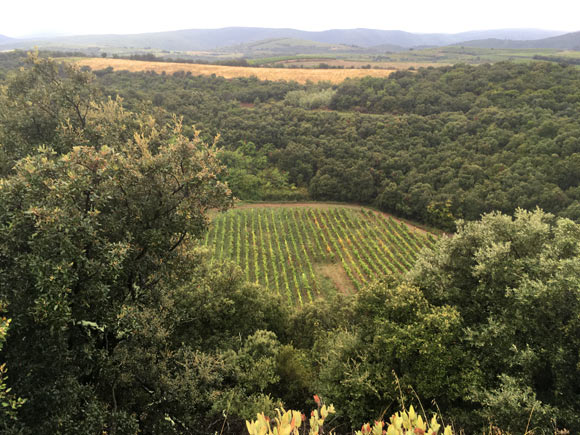The ancient crater, formally known as ‘le Clot,’ is about 220 m in diameter and 30 m in depth, and is located in the ground of the Domaine du Meteore-vineyard near the town of Béziers in southern France.
The 200-m-wide crater at the Domaine du Météore-vineyard in France. Image credit: Frank Brenker, Goethe University Frankfurt.
Small impact craters are quite rare, and proof of an impact origin is difficult to obtain, especially if remnants of the impactor material are missing.
The Earth Impact Database, hosted in the Planetary and Space Science Centre at the University of New Brunswick, lists only three structures in West and Central Europe: Rochechouart in France, Nördlinger Ries and Steinheimer Becken, both in Germany.
“Craters can form in many ways, and meteorite craters are indeed very rare,” said Professor Frank Brenker, a geologist and cosmochemist at Goethe University Frankfurt.
“However, I found the various other interpretations of how this depression at the Domaine du Météore-winery could have formed unconvincing from a geological perspective.”
First mentioned more than 70 years ago, the Domaine du Meteore crater was almost ignored for more than half a century.
In the 1950s, scientists suggested an impact origin of the crater based on its shape and a strong magnetic anomaly. However, their acclaimed colleagues rejected this hypothesis a few years later.
“The current crater has a 200-m wide and about 30-m deep circular shape with two stream beds crosscutting from north to south,” Professor Brenker said.
“The original size of the crater is difficult to assess as the overall topography is quite complex and intensive erosion from the nearby Montagne Noire might have eroded not only part of the crater rim.”
“It is also possible that the impact struck already intensively shaped terrain.”
Professor Brenker and his colleague, Goethe University Frankfurt’s Professor Andreas Junge, aimed to examine the Domaine du Meteore crater in detail.
With the help of strong magnets attached to a plate, they found tiny iron oxide spherules in the crater.
Further analysis showed that the specimens also contained nickel-bearing iron and encased a core of minerals typical for the crater environment.
In addition, they discovered numerous shock microdiamonds produced through the high pressure during the meteorite’s impact.
“Impact spherules in small craters are quite rare and have been reported from only a few occurrences worldwide,” they explained.
“A comprehensive study about magnetic spherules found in and around the Kamil crater in Egypt showed that even in small crater structures they can be quite frequent, with the potential of becoming one of the most important tools to detect and confirm new impact craters in the future.”
“Our search was performed by screening the soils by using a plate packed with high-energy magnets.”
“We isolated more than a hundred iron-oxide spherules showing a large variety of textures, from dentritic, ashlar to smooth surfaces was found.”
“The sizes range from a few 10s of microns to more than a mm, with a mean size of about 200 microns.”
The researchers also discovered that Earth’s magnetic field is slightly weaker in the crater than in the surrounding area.
This is typical for impact craters because the impact shatters or even melts the rock, which can thus contribute less to Earth’s magnetic field.
“The finding of a magnetic low inside the crater structure together with the occurrence of impact spherules containing target fragments set in a shock diamond matrix surrounded by silicon, aluminum-containing iron-oxide and remnants of nickel-rich iron-metal confirms the impact origin of the crater,” the authors concluded.
“Further proof comes from shock diamonds, mosaicism, planar fractures and planar deformation features in quartz of rare impact breccia.”
They will present the findings next month at the 54th Lunar and Planetary Science Conference 2023 (LPSC 2023).
_____
F.E. Brenker & A. Junge. Impact origin of the ‘Domaine du Meteore’-crater, France. Compelling mineralogical and geophysical evidence for an unrecognized destructive event in the heart of Europe. LPSC 2023, abstract # 2806




